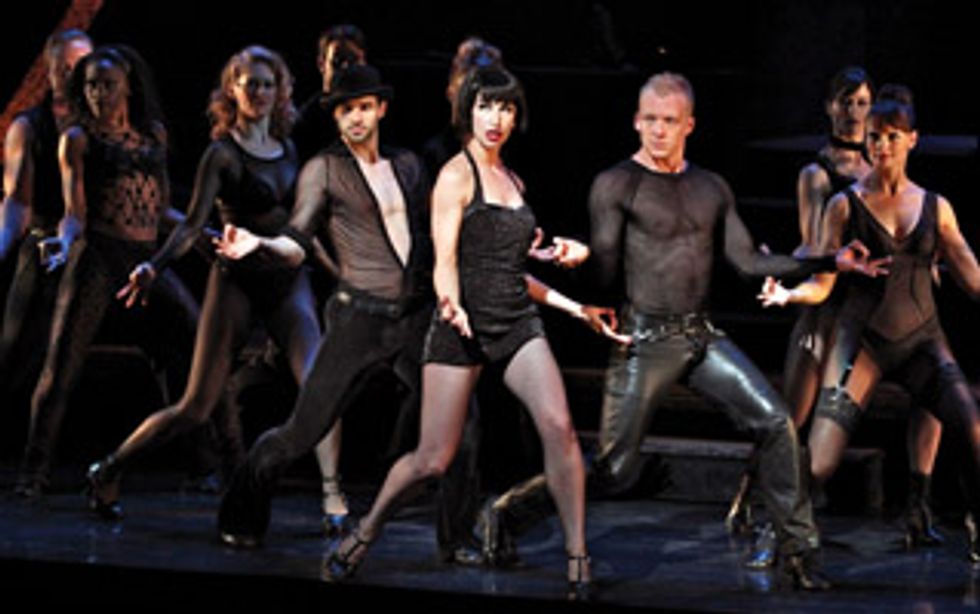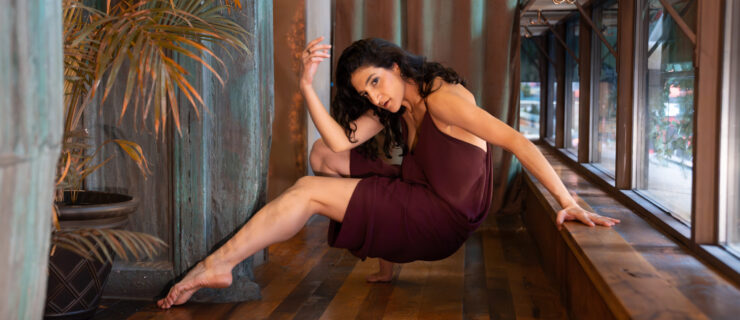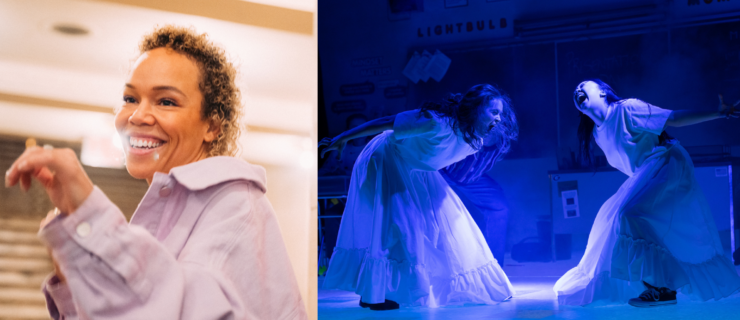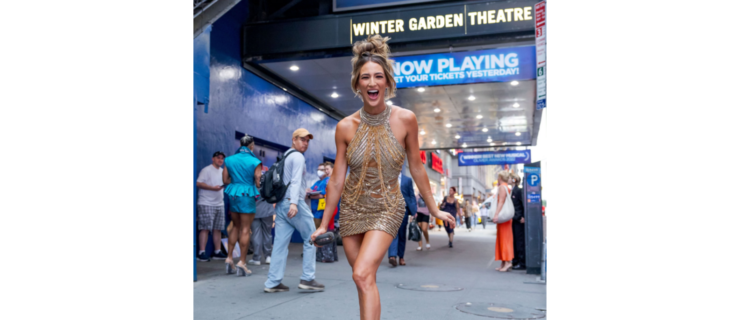Legendary Moves

Nikka Graff Lanzarone (center) as Velma Kelly in “Chicago” on Broadway. Photo by Jeremy Daniel.
The stage lights rise, revealing six feminine silhouettes behind jail bars. A spotlight shines down on each of their faces as they launch into the chilling lyrics, “He had it coming.” The first murderess emerges from her cell reenacting her crime verbally and physically, performing a series of ferocious kicks, dynamic turns and precise choreography. This is the beginning of Bob Fosse’s “Cell Block Tango”: an iconic number from the musical Chicago that continues to capture audiences whether it’s performed on Broadway, TV or even at your studio’s recital.
Fosse is best known for his signature jazz style, which features sultry hip rolls, smooth finger snaps, turned-in pigeon toes and specific, detailed movements. He changed Broadway forever in the 1950s, ’60s and ’70s with his groundbreaking choreography for musicals such as Damn Yankees, Sweet Charity, The Pajama Game and more. Although he died nearly 25 years ago, Fosse’s influence is still reverberating through the dance world. A revival of Chicago has been selling tickets on Broadway for the past 15 years, and another Fosse revival, Dancin’, is set to open on Broadway this spring.
Though mastering Fosse’s style is clearly a must for future musical theater mavens, it’s really an integral part of any young dancer’s education, because Fosse’s influence goes way beyond Broadway. Performers from Michael Jackson to Beyoncé have all been influenced by Fosse’s work, and classes in his style are regularly taught at studios and conventions around the country.
It can be challenging to execute the sometimes awkward-feeling Fosse movements while simultaneously conveying the story you need to tell. So DS caught up with Fosse masters to get their tips and tricks for nailing this iconic style.
Deceptive Simplicity
Most Fosse dancers say that the biggest challenge they face when learning his choreography is figuring out how to execute the detailed movements. “The work is fragile,” says legendary Fosse protégé Ann Reinking. “If you don’t do it with the specificity it needs, it can fall apart.” For example, “There’s something amazing about the beginning of his ‘Rich Man’s Frug’ from Sweet Charity,” says Nikka Graff Lanzarone, who plays Velma in Chicago on Broadway. “Really, all they’re doing is walking, but the way they’re walking [with rigid posture and their noses toward the ceiling] is telling you everything you need to know about the characters. It relies on such tiny details. And you have no tricks to hide behind, so you have to get them all exactly right.”
Fosse dancers must be able to isolate everything, right down to their eyeballs, elbows and fingers. When a Fosse dancer learns to focus her energy in stillness, she can grab the audience with a simple flutter of her fingers. “It should look like you’re not working at all—but you’ll come off stage sweating,” says Lanzarone.
Desmond Richardson, the co-founder of Complexions Contemporary Ballet who was nominated for a Tony Award for his performance in the musical revue Fosse, says he struggled with Fosse’s usage of hands and arms. “Your elbows are often back, and your hands are splayed forward,” he explains. “I could do it, but I wasn’t accustomed to it—it took some time. My arms would be really sore afterward. But now it’s in my body.”
Repetition is the key to mastering these small movements. “Fosse would take one count of eight and make you do it over and over and over,” says Broadway and Fosse veteran Rachelle Rak. “Something happens after all that repetition. Suddenly it feels good—you know, that feeling when you get something.”

Students learn “Rich Man’s Frug” in Diana Laurenson’s Fosse workshop at Broadway Dance Center in NYC. Photo courtesy Broadway Dance Center.
Theatricality
Fosse performers must tell a story. “Bob never called us dancers. He would always call us his actors, because everything he did came from an acting standpoint—from an idea or emotion,” says Diana Laurenson, a master theater dance teacher at Broadway Dance Center who worked personally with Fosse. “Every move you make is infused with character and story.”
It’s crucial that you develop an ability to control your movement while still maintaining a strong sense of intention. Laurenson warns against over-dancing. “Sometimes less is more,” she says. “There are moments in Fosse’s choreography when you don’t throw it in their laps. You want them to sit forward and come to you.” Reinking adds: “You’re almost quiet, and yet you come off as powerful—not necessarily big, but powerful. It’s as if you are doing a Shakespearean soliloquy. ‘To be or not to be’ has to be strong. The great actors don’t shout it, but it is strong.”
The best way to develop your control is to keep training in modern, jazz, tap and especially ballet. Some of the best Fosse dancers were ballet dancers first, including Reinking, Richardson and Elizabeth Parkinson. “I found that the same quality that was asked of me as a ballet dancer was asked of me as a Fosse dancer: That adherence and dedication to the line, and to making that line look good,” says Reinking. “You have to have the same clear, well-trained eye to perform Mr. Fosse’s work.”
Fosse Action Words
Bob Fosse used a variety of unique phrases to describe his signature movements, and many of these terms are still around today. Here, Broadway and Fosse veteran Rachelle Rak shares a few of her favorites to help you prep for your next Fosse class.
“Slow burn”:
An intense gaze that shifts slowly from one side of the stage to the other or from back to front. See it in Cabaret as Liza Minnelli faces upstage, then slowly turns in her chair to look at the audience before she sings “Mein Herr.”
“Broken doll walk”:
A pigeon-toed walk downstage. Your elbows
are glued to your torso,
jazz hands reach out to your sides and your hips swing slightly. See it in “Bye Bye Blackbird” in Fosse as the dancers sing “Here I go, swingin’ low.”
“Crescent jump”:
A jump in place with one leg in parallel coupé and the other straight. Jazz hands extend high above your head as you reach far to one side, making a “C”
with your body. See it
in “Sing Sing Sing” in Fosse—the dancers do it over and over again during the climax of the music.
“Soft-boiled-egg hand”:
A cupped-hand position. Imagine that you’re holding an egg just tight enough to avoid dropping or crushing it. See it in
“Bye Bye Blackbird” in Fosse.
The United States Postal Service will pay tribute to Bob Fosse by issuing a stamp featuring his image in April 2012.
See Fosse’s influence
on modern
artists for yourself! Compare Fosse’s “Snake in the Grass” (from The Little Prince) to a Michael Jackson performance of “Billie Jean.” And compare Beyoncé’s “Single Ladies (Put A Ring On It)” music video to Fosse’s “Mexican Breakfast.”




